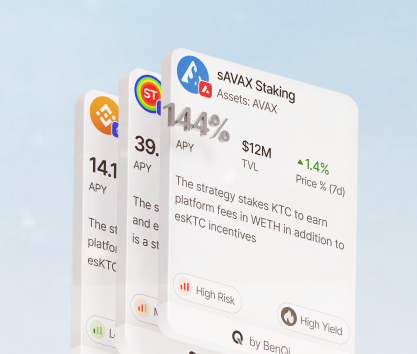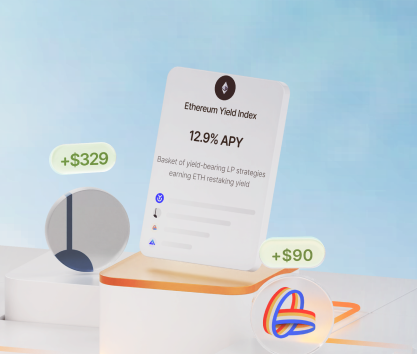Searching for the right balance between risk and potential returns is one of the biggest goals for any investor. Chasing high APYs is a fine avenue to take for anyone, but it is important to remember that portfolio exposure is a crucial aspect that can dramatically affect the outcome and completely nullify any gains made by staking holdings.
We are going to cover critical factors that should be accounted for during the initial planning of investment activities in the decentralized finance (DeFi) sector. Newcomers will benefit from this article the most since they need basic education. Let’s talk about managing risks, setting up profitability goals, and employing various tactics to avoid losses while trying to achieve consistent returns that beat inflation and high-yield bank deposits.
Advantages of investing in decentralized finance
Centralized systems are not democratic or free. Policymakers chosen by people are often driven by the needs of a few large capital holders and create laws that ultimately harm their voters. At the same time, overly tight regulations can prevent individual investors from actively participating in the economy and allocating holdings efficiently.
In many ways, decentralization is a perfect tool to address these issues. Here are the benefits of investing in DeFi protocols:
- Transparency. All operations on the blockchain are forever recorded and cannot be tampered with. The immutability of information is a cherry on top of another huge benefit: the data can be trusted and easily audited without the need to reveal the personal information of separate participants of the network. On the other hand, centralized systems are way less open.
- Inclusivity. The World Bank published a report during the World Economic Forum in Davos in 2023. The report contained a saddening statistic: over 70% of the global population is still unbanked or has no access to banking in general. The socio-economic effect that can be produced by the widespread adoption of DeFi is hard to imagine.
- No intermediaries. Remittance costs are some of the biggest drivers of price growth in the global economy. DeFi systems allow users to quickly send and receive capital while enjoying self-custody with all its benefits like better security and more control over finances. The absence of middlemen is believed to cut down remittance-related expenses by 80% according to the report by Uniswap.
- Security. If designed correctly, smart contracts act as excellent preventers of tampering with data or unfair play. Since functionality is embedded in the code, the execution does not require any human oversight making it safer for all market participants to engage in trading.
Contemporary investors find themselves strongly interested in exploring the world of decentralized finance precisely because of its flexibility and freedom granted to all participants. With the influx of cash and new users, the ecosystem had to adapt to keep capital holders from turning to other investment prospects.
Modern crypto enthusiasts can set up automated trading systems, enter long-term market positions, use derivatives, and hunt high yield DeFi investments. The latter is one of the most popular options for capital allocation in recent times. With some platforms offering exorbitant APYs reaching thousands of percent, the idea of staking assets feels outstandingly lucrative. However, it is imperative to consider the risks associated with putting holdings in pools.
The main goal of an investor is not to find the most outlandish combination of investment products that give the biggest number. One should focus on achieving consistency while avoiding dangers and trying to maximize returns.
The best yield farming strategies for risk aversion
The fear of loss is a natural response from any healthy human. The phenomenon of loss aversion where investors are more afraid of losing money than they are excited about making the same amount is well-studied and extensively documented. Interestingly enough, we do not have many studies focusing on the outcomes of using safe or risky investment styles. The vast majority of experts still believe that concentrated portfolios that do not account for risks perform worse in the long run.
Since DeFi protocols expose portfolios to a variety of dangers, it is important to know some of them as well as ways to mitigate their effects.
Avoiding the highest returns in DeFi
Decentralized exchanges and lending platforms have to attract users to remain operational. Depending on the severity and intensity of competition, measures taken to retain users can be drastic. Some protocols offer completely unsustainable APYs just to keep users from taking out their funds. An example of a fiasco caused by this approach is Terra Luna which lost over $45 billion in just a week when investors realized that the treasury could not back tokens in circulation.
An investor should be looking for protocols that have good track records and offer competitive yet reasonable APYs. MakerDAO has been around for over 6 years and still delivers good yields to users (reaching over 7% 30-day averages routinely). Additional products from the protocol like DSR and sDAI (liquid staking) also ensure that investors have ways to earn money while keeping their holdings in the DAO’s treasury.
Using top yield DeFi protocols
As mentioned previously, one of the critical steps in achieving consistent profitability is choosing the right platform to work with. Newer Dapps try to lure in users with APYs higher than 100% yet many succumb to rapid inflation or simply fail to deliver the promised rates. Many projects on the Solana blockchain suffer from this particular issue. Overnight on BASE is also a great example with its risky choices of DEXs and APYs over 10% for just holding stablecoins in their wallet.
We suggest choosing protocols based on several metrics:
- Longevity. Time-tested solutions like MakerDAO, LIDO, Compound, and others have good track records and the goodwill of their dedicated communities. It is a much better idea for any investor to trust their capital to these protocols.
- Real APYs. Over 60% of all Uniswap stakers lose money in the long run due to impermanent losses, sudden liquidation, and APYs lower than promised. Use on-chain analytics to find real rates and use multiday averages instead of base numbers to search for protocols suitable for capital allocation.
- TVL matters. Total value locked is a hugely important metric that indicates the general healthiness of projects and the level of trust from investors. The lower the TVL, the riskier it is to invest in the platform since insufficient reserves can harm their operations in the long term.
Focusing on DeFi yield optimization
Some approaches involve multiple layers of staking to achieve incredibly high APYs. For example, you can stake ETH on LIDO for 3.24%, receive stETH, wrap it, and receive wstETH to use as collateral to borrow DAI, receive DSR (up to 15%), and use sDAI to again borrow USDC on Ajna to stake it again. The overall returns can easily exceed 30% APY and higher even after extracting costs associated with servicing debt.
The problem is that these operations add to the exposure and may lead to significant financial losses if not managed correctly. We suggest using one of the methods below (or combine them) to reduce risks and achieve higher returns:
- Diversify investments. It is a good idea to have a mixed bag of positions. Having stakes on ORCA (Solana) for huge returns SOL-USDC holdings (up to 145% APY) alongside conservative positions in MakerDAO (close to 7%) and LIDO (roughly 3.2%) is a good idea.
- Hedge against risks with derivatives. Trying to create a delta-neutral market position is a good idea for investors to protect their holdings from market risks. Perpetual futures on ETH can be used to short-sell staked assets if something goes wrong and your locked funds are in danger of being forcibly liquidated.
- Do not stack too much. The aforementioned example of layering staking positions is quite extreme. However, some newcomers are excited to use it attracted by incredibly high returns. We strongly advise against overexposing!
- Avoid taking on debt. Leveraged liquidity mining or yield farming in general can be incredibly dangerous and less profitable than expected since it is hard to reliably calculate APYs and you have to service debt by paying interest. Finding the right balance can be challenging even for experienced investors.
Optimizing returns is like scratching the right itchy spot. Too hard, and you end up with bruises. Too soft, and it stays itchy. Identify the tolerable level of risk and search for platforms that allow you to feel safe while earning interest on staked holdings.
Maximizing yield in DeFi
There are two main methods of amplifying returns on investments in the DeFi ecosystem:
- Layering staking positions. We have already covered one of the most extreme examples of layering that has several weak points like the failure of Ajna or lower-than-expected yields on staked USDC borrowed from Ajna. However, you can use this method in moderation. You can get stETH from LIDO and use tokens on Uniswap for additional rewards achieving a nice APY higher than any tradfi deposit will get you.
- Leveraged staking in DeFi. Taking on debt to amplify a market position seems like a good idea on paper. The issue is that debt must be paid back with interest on top. So many things can go wrong with that. For example, you may miss an unbounding window and fail to serve your debt resulting in penalties. APYs from staking may never cover interest payments. A staked position may suffer from impermanent loss or other issues.
These approaches allow investors to reach higher APY numbers yet come with apparent risks and should be used very carefully.
Some examples of DeFi income strategies:
- You can allocate capital to Balancer and receive up to 16% on stablecoin stakes. This particular protocol is not the most reliable out there but it has good support from the community and pays high interest rates.
- Delta-neutral leveraged farming is also an interesting approach that requires some calculations and readiness to engage in trading on centralized platforms. Short-selling ETH while having a leveraged stake in ETH saver can generate impressive net positives for any portfolio.
Use OpenEden for fixed returns. This protocol is unique as it offers a way to earn US government treasury rates on USDC holdings through TBill. At the time of writing, the rate is 4.91% and can change for the better in the future.
The ecosystem has many interesting protocols that have the necessary features to offer good APYs. We want to focus on options that are safer yet still give you yields much higher compared to tradfi instruments and many popular DeFi projects.
Below are some of our top picks:
- Aave gives high APYs for SUSHI and GHO (ranging from 23% to 26%). You can also stake stablecoins like USDC or SUSD for much lower (roughly 7%) rates. The protocol is one of the most popular platforms with over $21 billion in TVL and extremely good yields for some digital assets.
- Pendle is a slightly riskier option with good rates for pools with wrapped ETH (11.8% 30-day average on weETH) and sUSDe (over 10.6% base rate). With $2.74 billion in total value locked, it is one of the most impressive projects for yield farming. Even the native token is doing great climbing 180% from its launch price.
- Uniswap has several pools offering massive returns with some caveats. For example, the liquidity pool for wrapped ETH and USDC has been generating over 98% APY with daily compounding for quite a while now. Note that real returns can be lower and the entry barrier to this particular pool is quite high.
Aerodrom Finance, Beefy Finance, and DeDust are also interesting options. These protocols promise high returns and enjoy popularity among crypto enthusiasts.
Top DeFi yield opportunities
Investors who are not afraid to risk their capital can make a bet on emerging and overtly generous protocols:
- ORCA’s SOL/DOGS and SOL/PEPU pools are focused on meme coins and have exorbitant APYs with 30-day averages going above 5,000%. With both pools having over $27 million in TVL, they seem to be quite reliable and produce good returns in meme assets if you are interested in them.
- Merkel’s wrapped BTC and ETH pool pays 113% APY in ARB rewards with 30-day averages reaching 533%. it is one of the most generous projects on the Arbitrum blockchain. Approach with caution and think twice before investing.
- Storm Trade on The Open Network pays 32.75% base APY on TON holdings. The platform has not yet issued native tokens which can arrive in the form of airdrop sometime later this year. You can also check out their USDT pool with a massive 57.50% base rate.
We remind you that it is important to consider risks before investing in these platforms. High APYs are worth it only if you can liquidate rewards and cover investment costs.
The main takeaway
It is more than possible to find a good balance between risks and high yields in the DeFi ecosystem. An investor has to comb through thousands of pools (there are over 11,000 tracked ones) and consider a variety of dangers before committing to a strategy that usually involves putting “eggs” into multiple different “baskets” that look reliable.









